The Cinnamon Hummingbird (Amazilia rutila) graces the American landscapes with its dazzling presence, captivating bird enthusiasts with its vibrant plumage and agile flight.
This species, belonging to the Trochilidae family, showcases a distinctive cinnamon-colored upper plumage, accentuated by an iridescent throat that glows with hues of orange or red.
Found in regions extending from southern Mexico through Central America to western Panama, the Cinnamon Hummingbird thrives in diverse habitats, from open woodlands to gardens and forest edges.
Known for its territorial behavior and elaborate courtship displays, this medium-sized hummingbird plays a crucial role as a pollinator while relying on a diet rich in nectar from a variety of flowering plants.
As a symbol of elegance and ecological significance, the Cinnamon Hummingbird continues to captivate observers, making it a cherished subject in the realm of avian wonders. Stay focused.
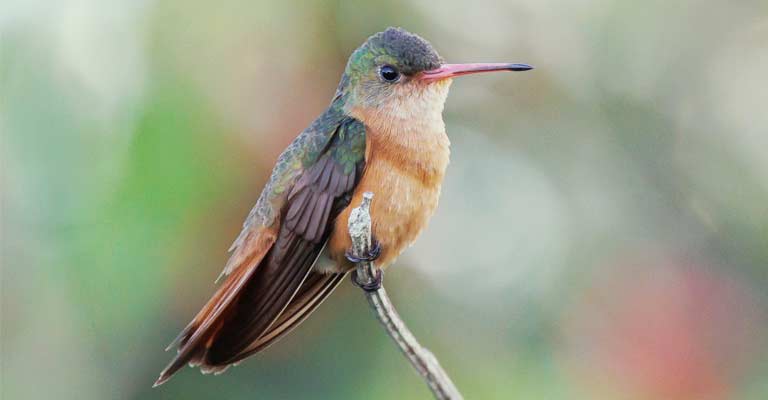
Identifying Characteristics of Cinnamon Hummingbird
The Cinnamon Hummingbird (Amazilia rutila) is a mesmerizing bird species found in the Americas, known for its vibrant plumage and agile flight.
Identifying this specific hummingbird involves paying close attention to various physical characteristics and behaviors that set it apart from other hummingbird species.
Here are some key points to help you identify the Cinnamon Hummingbird:
Distinctive Plumage
One of the most striking features of the Cinnamon Hummingbird is its cinnamon-colored plumage, which gives the bird its name.
The upper parts, including the head, back, and wings, exhibit a rich cinnamon hue, while the throat and breast may display a brilliant iridescent orange or reddish color.
White Vent Area
Unlike some other hummingbird species, the Cinnamon Hummingbird typically has a white vent area. This refers to the region underneath the bird’s tail, which contrasts with the cinnamon-colored upperparts.
Observing this white vent can be a crucial characteristic for accurate identification.
Size and Shape
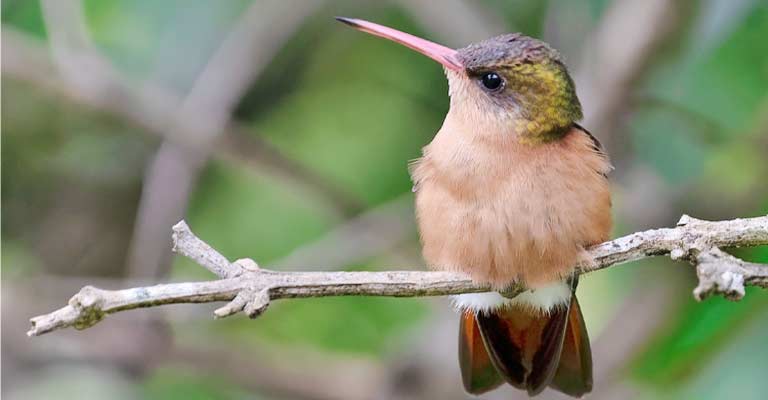
In terms of size, the Cinnamon Hummingbird is a medium-sized hummingbird with a length of around 9 to 10 centimeters (3.5 to 4 inches). It has a slender body and a relatively short, straight bill.
The wings are long and pointed, allowing for swift and agile flight.
Distinctive Markings
The bird’s facial markings are distinctive, featuring a stripe behind the eye and a line extending from the eye to the nape of the neck.
These markings, along with the overall cinnamon coloration, contribute to the bird’s unique appearance.
Forked Tail
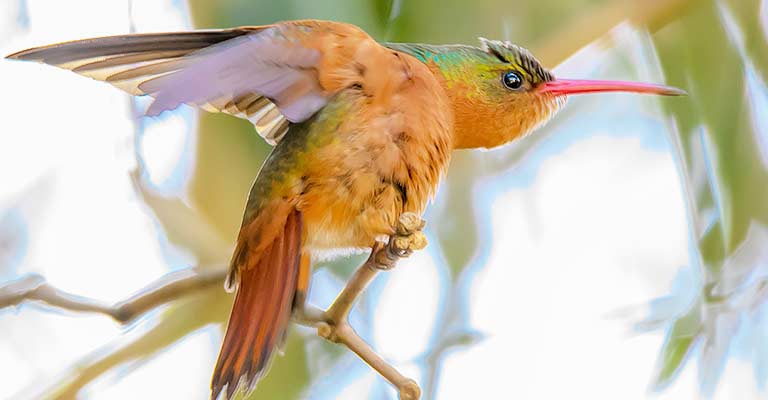
The Cinnamon Hummingbird is characterized by its forked tail, which sets it apart from hummingbirds with square or slightly notched tails.
The tail feathers are typically elongated and slender, adding to the bird’s graceful appearance during flight.
Iridescent Throat
While the main body color is cinnamon, the throat of the Cinnamon Hummingbird often displays iridescence.
Depending on the lighting conditions, the throat may appear to shimmer with shades of orange or red.
This feature is especially noticeable during the bird’s aerial displays and feeding.
Preferred Habitat
Understanding the habitat preferences of the Cinnamon Hummingbird can aid in identification. These birds are often found in open woodlands, gardens, and forest edges.
Their choice of habitat, combined with their distinctive coloration, helps differentiate them from other hummingbird species.
Vocalizations and Behavior
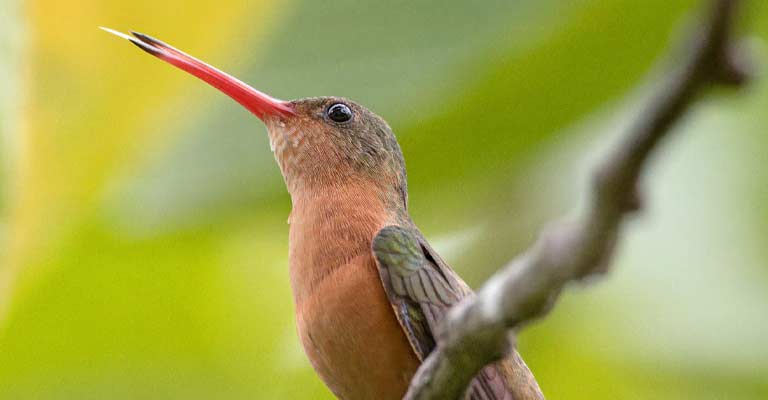
Cinnamon Hummingbirds are known for their vocalizations, which include sharp, high-pitched chirps.
Observing their behavior, such as their feeding patterns and aerial displays, can also contribute to accurate identification.
These birds are territorial and may exhibit aggressive behavior towards other hummingbirds in their vicinity.
Identifying the Cinnamon Hummingbird involves a combination of visual cues related to plumage, size, markings, and behavior.
Taking note of these distinctive characteristics can enhance the birdwatching experience and contribute to a deeper understanding of this enchanting hummingbird species.
Taxonomy of Cinnamon Hummingbird
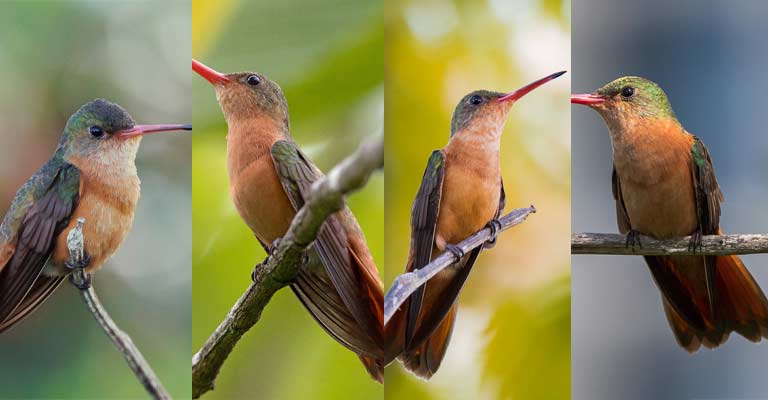
Here’s a table summarizing the taxonomy details of the Cinnamon Hummingbird (Amazilia rutila):
| Taxonomic Rank | Classification |
| Domain | Eukaryota |
| Kingdom | Animalia |
| Phylum | Chordata |
| Class | Aves |
| Clade | Strisores |
| Order | Apodiformes |
| Family | Trochilidae |
| Genus | Amazilia |
| Species | A. rutila |
Understanding the taxonomy of this bird provides a systematic framework for classifying and studying its biological relationships within the broader context of the animal kingdom.
The Cinnamon Hummingbird (Amazilia rutila) is a species with a fascinating diversity, as reflected in its four recognized subspecies.
Each subspecies exhibits distinctive variations in plumage, size, and distribution, contributing to the overall richness of the species. Here is a brief overview of the identified subspecies:
- Amazilia rutila diluta (Van Rossem, 1938): This subspecies is characterized by its diluted coloration, suggesting a softer or less intense cinnamon hue compared to the typical Cinnamon Hummingbird. The subtle variations in plumage contribute to the uniqueness of Amazilia rutila diluta.
- Amazilia rutila graysoni (Lawrence, 1867): The graysoni subspecies, named after the American ornithologist George N. Lawrence, exhibits specific characteristics that distinguish it within the Cinnamon Hummingbird species. These distinctions may include variations in size, color, or other morphological features.
- Amazilia rutila rutila (DeLattre, 1843): This is the nominate subspecies, representing the standard or typical form of the Cinnamon Hummingbird. The subspecies name “rutila” is derived from its rich cinnamon-colored plumage, making it the reference point for comparison with other variations.
- Amazilia rutila corallirostris (Bourcier & Mulsant, 1846): The corallirostris subspecies is notable for specific characteristics, potentially including variations in the coloration of its bill or other distinctive features. The name “corallirostris” may imply a correlation with coral, suggesting unique coloration in certain parts of its anatomy.
Studying these subspecies provides ornithologists and bird enthusiasts with a deeper understanding of the evolutionary and ecological dynamics within the Cinnamon Hummingbird population.
The variations observed among subspecies contribute valuable information to ongoing research and conservation efforts, aiding in the preservation of the species as a whole.
Cinnamon Hummingbird Life History
The Cinnamon Hummingbird (Amazilia rutila) enchants bird enthusiasts with its vibrant plumage and graceful flight.
Understanding the life history of these captivating birds provides valuable insights into their behavior, reproduction, and conservation needs.
In this exploration, we delve into the various facets of the Cinnamon Hummingbird’s life history, including its food preferences, range map, nesting habits, potential treatments, and ongoing conservation efforts.
Food
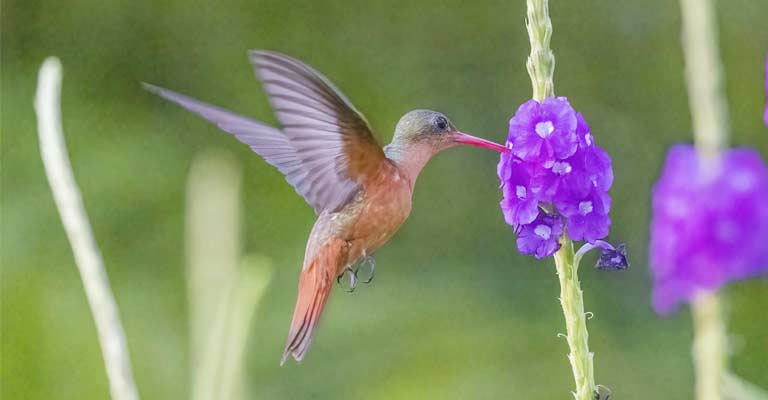
Cinnamon Hummingbirds are nectarivores, primarily feeding on the sweet nectar produced by a variety of flowering plants.
Their long, specialized bills and extendable, tube-like tongues allow them to access the deep crevices of flowers to extract nectar.
In addition to nectar, these hummingbirds supplement their diet with small insects and spiders, providing essential proteins and nutrients.
Their feeding behavior contributes to pollination, making them crucial for the reproductive success of numerous plant species.
Habitat
Cinnamon Hummingbirds inhabit a range of environments, including open woodlands, gardens, and forest edges. They are often found in regions with abundant flowering plants, as these serve as a critical food source.
The availability of suitable perching sites and nesting locations influences their choice of habitat. The bird’s adaptability to different environments has contributed to its widespread distribution across its range.
Range Map
The range of the Cinnamon Hummingbird extends from southern Mexico through Central America to western Panama.
A detailed range map provides insights into the specific regions where these hummingbirds are commonly observed.
Understanding their distribution helps researchers and conservationists implement targeted measures to protect their habitats and address potential threats.
Nesting
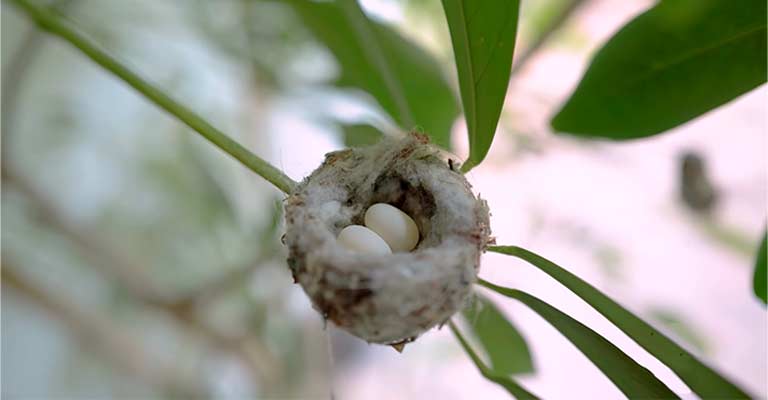
Cinnamon Hummingbirds are meticulous nest builders, constructing small, cup-shaped nests using plant fibers, moss, and spider silk.
These nests are often placed on horizontal branches or in the fork of a tree, providing stability and protection for the eggs and chicks.
The female is primarily responsible for nest construction, incubation, and caring for the young.
Below is a table summarizing nesting details for the Cinnamon Hummingbird:
| Nesting Details | Facts |
| Clutch Size | Typically 1 to 3 eggs |
| Number of Broods | Often raise more than one brood per season |
| Egg Length | Approximately 1.0 to 1.2 centimeters |
| Egg Width | Around 0.5 to 0.6 centimeters |
| Incubation Period | Approximately 14 to 19 days |
| Nestling Period | Approximately 20 to 26 days |
| Egg Description | White or creamy-white in color, small and elliptical |
| Nest Type | Cup-shaped, constructed with plant fibers, moss, and spider silk |
| Nest Placement | Positioned on horizontal branches or in the fork of a tree |
| Parental Care | Female primarily responsible for incubation and caring for the young |
| Courtship and Mating | Males engage in elaborate displays, including aerial acrobatics and vocalizations |
Understanding these nesting details provides valuable insights into the reproductive behavior of the Cinnamon Hummingbird and contributes to efforts aimed at their conservation and protection.
Breeding
The breeding season for Cinnamon Hummingbirds varies across their range. Males engage in elaborate courtship displays, including aerial acrobatics and vocalizations, to attract potential mates.
After mating, females lay one to three eggs, and the incubation period lasts around 14 to 19 days. The fledglings remain in the nest for a few more weeks before becoming independent.
Diseases
Hummingbirds, including the Cinnamon Hummingbird, may be susceptible to various diseases, such as avian pox and respiratory infections.
Monitoring their health is crucial for both individual bird well-being and broader conservation efforts.
Treatment
In cases where diseases are identified, prompt intervention is essential. Rehabilitation centers equipped to handle hummingbirds can provide necessary medical care, including antibiotics and supportive measures.
Public awareness campaigns about proper feeding practices and maintaining clean feeders can contribute to disease prevention.
Conservation
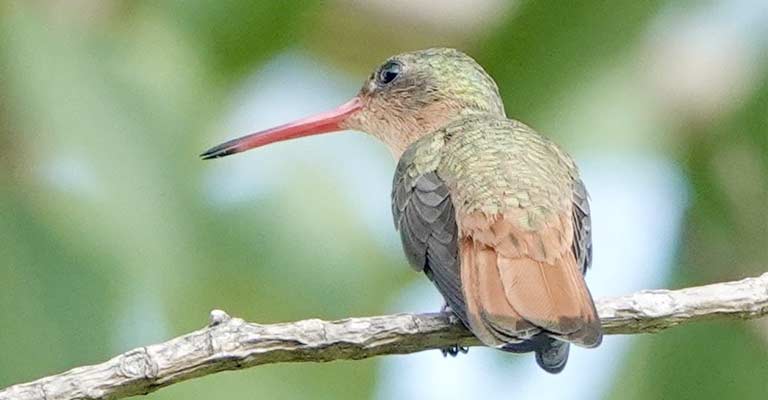
Conservation efforts for the Cinnamon Hummingbirds focus on preserving their natural habitats, ensuring the availability of suitable foraging and nesting sites, and addressing potential threats such as habitat loss and climate change.
Collaborative initiatives between researchers, conservation organizations, and local communities play a pivotal role in safeguarding the future of these enchanting birds.
The life history of the Cinnamon Hummingbird encompasses a complex interplay of ecological interactions, reproductive strategies, and conservation challenges.
By unraveling the intricacies of their lives, we gain a deeper appreciation for the importance of preserving their habitats and ensuring the continued existence of these remarkable hummingbirds in the wild.
10 Fun Facts About Cinnamon Hummingbird
The Cinnamon Hummingbird (Amazilia rutila) is a fascinating species, and exploring some of its fun facts adds a delightful dimension to appreciating these vibrant birds.
- Vivid Plumage: The Cinnamon Hummingbird boasts a stunning cinnamon-colored plumage, particularly on its upperparts, giving it a distinctive and eye-catching appearance.
- Iridescent Throat: Adding to its charm, the hummingbird’s throat displays iridescence that can shimmer with hues of orange or red depending on the lighting conditions, creating a captivating visual display.
- Forked Tail: Unlike some other hummingbird species with square or slightly notched tails, the Cinnamon Hummingbird is recognized by its distinctive forked tail, enhancing its graceful in-flight maneuvers.
- Territorial Behavior: These hummingbirds are known for their territorial nature, defending feeding and nesting areas vigorously. This behavior adds a touch of drama and energy to their interactions with other birds.
- Migratory Patterns: While some populations are resident year-round, others undertake seasonal migrations. Understanding their migratory patterns adds an element of adventure to tracking these birds across different regions.
- Agile Flight: Cinnamon Hummingbirds are agile flyers, capable of intricate aerial maneuvers. Their rapid wing beats and hovering abilities make them a joy to observe as they navigate through their environments.
- Nectarivores with a Twist: While their primary diet consists of nectar from flowering plants, these hummingbirds also consume small insects and spiders, showcasing their adaptability in obtaining essential nutrients.
- Elaborate Courtship Displays: During the breeding season, male Cinnamon Hummingbirds engage in elaborate courtship displays, showcasing acrobatic flights and vocalizations to attract potential mates.
- Multiple Broods: Cinnamon Hummingbirds often raise more than one brood per breeding season, demonstrating their reproductive resilience and adaptability.
- Contributors to Pollination: As avid nectar feeders, Cinnamon Hummingbirds play a crucial role in pollination, aiding in the reproduction of various flowering plants and contributing to the ecological balance of their habitats.
The Cinnamon Hummingbird is not just a visually stunning bird but also a species with captivating behaviors and ecological significance. These fun facts offer a glimpse into the intricate and dynamic world of these enchanting hummingbirds.
Wrapping Up
The Cinnamon Hummingbird emerges as a captivating subject, blending vibrant plumage, agile flight, and intricate nesting behaviors. From its territorial antics to migratory patterns, each facet reveals a unique story.
With vivid iridescence and a penchant for multiple broods, these hummingbirds enchant both casual observers and dedicated bird enthusiasts.
Their role as pollinators adds an ecological dimension to their charm, emphasizing the importance of conservation efforts.
As we explore the Cinnamon Hummingbird’s life history and nesting intricacies, we gain not just knowledge but a profound appreciation for the delicate balance these birds maintain in their ecosystems. Best of luck.